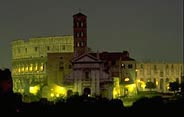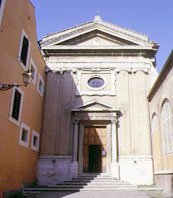Little Gems
St. Francesca Romana
 A wedding church, where there is the occasional sacred music concert during religious holidays.
A wedding church, where there is the occasional sacred music concert during religious holidays.
St. Frances is the patron saint of motorists. Taxi drivers throng here on March 9, the Saint's Day, when her mummified body is paraded.
Bell Tower. Always easy to tell a Romanesque (10C – 13C) steeple by its 3 (or more, but always an uneven number) stories, with baby columns and marble plates (in this case, real plates) marking each story. This one is a real beauty.
The facade, now Baroque, was tampered with, ameliorated, by Carlo Lombardi in 1615, during the frenzy of the Counter Reformation.
Inside. There is a 17C coffered ceiling. Two paving stones from Via Sacra showing the imprints of St Peter's knee as he prayed hard while the magician Simon Mago performed wizardry by flying around him (behind a grille in the South wall).
In 1950 while cleaning the 19C altar painting they discovered a 12C one, now in situ underneath. Underneath this they found the oldest Christian painting ever (5C), which they managed to separate from the one above (12C) and it is now on display in the sacristy.
Apse. Byzantine mosaic of the Madonna and Saints, full of bright colors, is from 1161.
|
St. Francesca Romana
History 757-67 AD. Pope Paul I built this medieval Oratory (for sermonizing but not celebrating Mass), dedicated to Saints Peter and Paul, tucked into the western flank of Emperor Hadrian's Temple of Venus and Rome. 9C. When the Church of Santa Maria Antiqua in the Forum collapsed, it was moved here and the name became Santa Maria Nova. 1608. The churcht was renamed after Francesca, canonized that year. |
Entrance from Via dei Fori Imperiali (Map J 7)
St. Sebastiano in Pallaro
A bit of a walk down a cul-de-sac to see two tiny churches, but history buffs will enjoy their obscurity. Ring the bell if the iron gates are closed.
In addition to the 17 C portal with Barberini bees, and a tranquility in the gardens left over from the medieval monks who lived here, inside in the apse is an exquisite fresco (10 C). Once the church was covered with such frescoes. (17 C copies, made while they were still visible, are in the Vatican Library).
|
St. Sebastiano in Pallaro
History 14-37 AD. Here Emperor Tiberius built a temple to Augustus. 81-96 AD. Emperor Domitian had an oriental garden here. Nearby St. Sebastian was shot full of arrows. 1623-44. Restored by Pope Urban VIII Barberini whose family had a vineyard nearby. |
Via di S. Bonaventura (Map J 8)
St. Bonaventura
Even more obscure - and after all, those are sometimes the most thrilling things to discover - after sagging along this lane of "Via Crucis" 18 C terracotta bas-reliefs, one comes to a little church (17 C). No guide book has written anything about it, we wonder why?
St. Prisca
 Aquila and his wife Priscilla (or Prisca) mentioned in the “Epistles of Paul” were said to have lived here, welcoming St. Paul on this spot. Both he and Aquila were Jewish tent makers.
Aquila and his wife Priscilla (or Prisca) mentioned in the “Epistles of Paul” were said to have lived here, welcoming St. Paul on this spot. Both he and Aquila were Jewish tent makers.
The area became a Christian cemetery in the early 5 C and a church was added 2 centuries later.
Priests from it attended Church Councils (in 499 and 595). In the Middle Ages it was one of the 20 abbeys of Rome. It was reconstructed in the 17 C and 18 C.
Beneath the church. A nymphaeum with a small museum, crypt and a 2 C Mithraeum, Temple of the military god Mithras, were discovered in 1933. Frescoes and a statue of Mithras killing the Bull were found 15 years later. 1 C houses have been found here, some attributed to Emperor Trajan and his friend Licinius Sura.
Once inside the church, the boring facade (1660, Carlo Lombardi) is soon forgotten as the 4C building envelopes you. (interior restored in 1456). Underneath is the Antequarium, a Roman house which belonged to Aquila and Prisca, as mentioned in St. Paul's Epistles. A door in the right nave leads to an earlier temple of Mithras, the soldier's bloodthirsty cult; fresco bits and sculptures discovered in 1940 were painstakingly put together by Dutch archeologists, so now we understand Mithraism better.